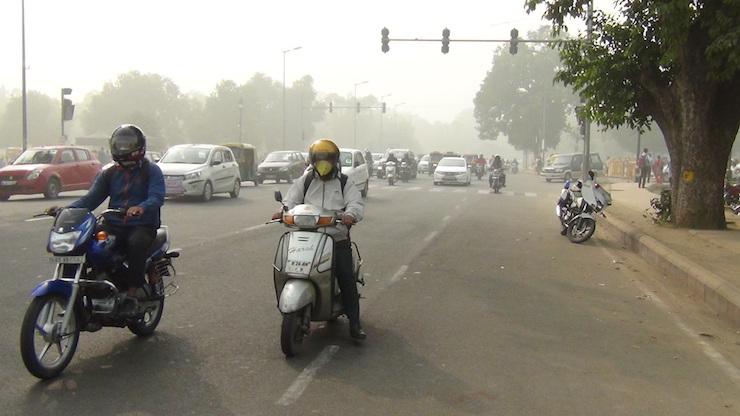ASIACALLING
Pollution levels skyrocket in Delhi on the back of Diwali
"Smog has engulfed New Delhi for weeks – evoking calls for drastic measures to deal with what experts have said is a health emergency."
Bismillah Geelani

India’s Supreme Court has imposed a complete ban on firecrackers in the capital New Delhi. The decision comes in the wake of unprecedented levels of air pollution recorded in the city following the Hindu festival of Diwali last month.
Smog has engulfed the city for weeks – evoking calls for drastic measures to deal with what experts have said is a health emergency.
Bismillah Geelani has the story.
Transcript -
Forty-five-year-old Haripriya is a lawyer and a mother of 3 school-aged children.
Until a few weeks ago she was seriously considering leaving India permanently to protect her children from Delhi’s growing air pollution.
“Every month one of my eldest two girls is at the pediatricians, my second daughter today is on a steroid nasal spray because of an allergic cough that refuses to go away and we see a total apathy from the administration,” said Haripriya.
She believes it’s time to look at whether the government is doing anything about the problem.
Haripriya was waiting for the decision on a petition that she and some other parents filed at the Supreme Court, urging the court to intervene and make the city’s air breathable.
One of their demands was for the court impose a complete ban on firecrackers.
“Public interest is supposed to outweigh all other considerations in law,” Haripriya argued.
“So if you find that an already polluted city is going to get even more polluted because of firecrackers, then I think it is high time for a ban.”
Haripriya continued, “I don’t see the point of bursting firecrackers, it causes noise pollution, it causes air pollution and I don’t understand why it should be an integral part of Diwali at all.”
The court verdict banning the sale, purchase and bursting of firecrackers in Delhi has renewed Haripriya’s hope that things might change.
But Delhi’s air quality has deteriorated badly over recent years. The World Health Organization has already declared Delhi the most polluted city in the world.
And this year, pollution levels touched unprecedented heights, leaving residents gasping for breath.
Fifty-year-old Shiv Narayan, an auto rickshaw driver says it is the worst air condition he can remember.
“It has never been like this. The burning in the eyes and throat is much more this time and it worries me,” he said.
“What will happen to us and our children if it continues to get worse? We can’t lock down ourselves in the house like our elders,” Narayan asked.
The major pollutants in the air are expressed in terms of fine particles known as Particulate Matter, or PM.
According to experts the PM levels in Delhi always remain several times higher than the safe limits but they are reaching more dangerous levels now.
PM levels this November reached 28 times higher than what the WHO considers safe.
On top of the most recent complaints about firecrackers, pollution levels are often blamed on neighboring states.
But environmental activist Vimlendu Jha says the bigger problem is within the city itself.
“40-45 % of Delhi’s pollution is very local and it is from construction and dust waste.”
Jha went on, “15-20 % of the pollution is from Delhi’s vehicles, and almost an equal amount of pollution is from industries that are completely unregulated in the Delhi area.”
“So it will be very convenient for us to say that it is the periphery, it is these events that are triggering Delhi’s pollution to reach the levels that it has reached, but it is very local issues of Delhi that have actually led us to the state that we are in,” concluded Jha.
Delhi’s Chief Minster Arvind Kajriwal recently announced a slew of measures to curb pollution, including putting all construction on hold, shutting down a power generation plant, installing air purifiers, sprinkling water on roads to settle the dust, and organizing artificial rain.
Chandra Bhushan, Deputy Director of New Delhi-based Centre for Science and Environment, isn’t convinced though.
“We had an action plan, we exactly knew what to do. We had to remove dust from road, we had to crackdown on construction sites, we had to work with Punjab and Haryana and incentivize farmers not to burn, we had to make sure that more buses are available on the road so that people can drive less,” Bhushan stated.
“We had a complete action plan in place.”
But he says, nothing happened.
“And on top of it we are saying we will put air purifiers at 5 intersections as if a miracle will happen in the city and air will get cleaned. Are we stupid? Everyone knows that these things don’t work,” Bhushan claimed.
He believes that there are hard actions that can be taken, and that would be effective. But those steps haven’t been taken.
However, the Supreme Court has taken serious note of the situation.
Apart from banning firecrackers, the court has also directed the central government to submit a complete roadmap of how it plans to clean Delhi’s dirty air.
- New Delhi
- India
- Pollution
- Diwali
- Bismillah Geelani
- air pollution
Komentar (0)
KBR percaya pembaca situs ini adalah orang-orang yang cerdas dan terpelajar. Karena itu mari kita gunakan kata-kata yang santun di dalam kolom komentar ini. Kalimat yang sopan, menjauhi prasangka SARA (suku, agama, ras dan antargolongan), pasti akan lebih didengar. Yuk, kita praktikkan!